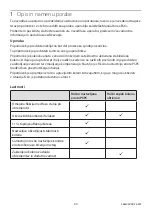
7
4
Function
The device is a uniaxial design comprising a knee pivot connecting a chassis to a carrier. A weight
activated stabilizing knee mechanism is housed within the chassis. The stabilizing mechanism
has a resilient action which provides limited stance flexion under load to absorb shock loads at
heel strike.
The device incudes a manually operated knee lock mechanism which, when activated by
the user, automatically engages at full knee extension and prevents any further knee flexion
regardless of applied body weight.
When de-activated, the knee returns to weight activated stabilization.
A pneumatic control cylinder sits within the carrier assembly, fitted between the chassis posterior
pivot and the carrier distal pivot.
The cylinder has manually adjustable valves which give independent control of flexion and
extension resistance during swing phase.
5
Maintenance
Visually check the device regularly.
Report any changes in performance of this device to the practitioner/service provider e.g.
unusual noises, increased stiffness or restricted/excessive rotation, significant wear or excessive
discoloration from long term exposure to UV.
Inform the practitioner/service provider of any changes in body weight and/or activity level.
Cleaning
Use a damp cloth and mild soap to clean the outside surfaces. DO NOT use aggressive cleansers.
The remaining instructions in this section are for practitioner use only.
This maintenance must be carried out only by competent personnel (practitioner or suitable
trained technician).
To maintain optimum performance, a periodic inspection for unacceptable noise, play and
stability is recommended. The period between inspections is determined by factors such as the
activity of the user, frequency of usage and the stability setting of the knee.
As a guide, if the setting is 6 clicks or above and the user averages 600,000 steps per annum, an
annual inspection is recommended.
We recommend adjusting the knee to the individuals’ stability requirements to ensure optimal
stability and durability. See adjustment guide/flow diagram.
The use of a Limb Activity Monitor is recommended to determine step count.
At these inspections:
• Check for visual defects that may affect proper function.
• Check condition and satisfactory operation of thigh release cable.
• Dis-assemble, clean and re-assemble knee mechanism.
938405PK2/2-0322







































